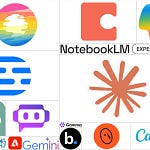ChatGPT is the most powerful AI tool. It’s useful for dozens of daily tasks — from idea generation to editing suggestions. To get the most out of ChatGPT, today’s post offers the following guidance:
How to get ChatGPT to do what you want
What ChatGPT is most useful for
How to make the most of its multimedia capabilities
When to use alternatives like Claude, Bing and Bard
There’s also a short video overview, above — or watch it on YouTube.

1️⃣ First, catch up on the basics of ChatGPT
Wonder Tools 🤖 7 ways to Use ChatGPT
ChatGPT is a remarkable new chatbot that uses artificial intelligence to answer any question you pose. It’s a powerful free digital assistant for research or writing. Read on for how it works, seven ways to use it for writing, and five related resources.
Boost ChatGPT with new plugins 🚀
In May, more than 1.8 billion people used ChatGPT, an AI chatbot that generates human-like text. ChatGPT recently enabled new plugins. Each is linked to an online service, allowing you to plan travel, create diagrams, search contacts and more. Read on for how to make the most of ChatGPT plugins, along with caveats.
2️⃣ How to Prompt Effectively
To get ChatGPT to do what you want, you have to give it clear, detailed instructions. Use a framework I call POP to consistently get useful responses.
Persona
Tell ChatGPT what role you want it to play. That helps ensure it brings a useful perspective to whatever you want it to do.
Examples: “Act as an expert podcast interviewer adept at developing thoughtful, engaging questions.” Or “Act as an experienced college educator skilled at providing simple, scaffolded instructions to students who face executive functioning challenges.”
Why this matters: When it knows the perspective you’re seeking, the AI can provide you with a more relevant response.
Objective
Give ChatGPT a clear summary of what you’re seeking. Be as specific as possible and include as much context as you can.
Examples:
“Suggest 7 key questions helpful to consider when making a decision about X in the context of Y.”
Useful for avoiding blindspots and opening your mind to aspects of a decision you may otherwise neglect.
“Provide potentially engaging alternative headlines/subject lines/descriptions for a story/email/video that addresses X, Y, and Z and makes the following key points: A, B and C.”
Useful for sharpening the way you market your social media posts or other published work.
“Give me three simple ways to explain the concept of X to people in XYZ context.”
Useful for explaining things to people outside your field, whether a technical concept like regression to the mean or any specialized jargon.
Parameters
Provide guidelines that ensure ChatGPT’s response is useful.
Examples: If you want headlines that are four words or less, say so. If you want a response worded to be understood by an 11-year-old who speaks only Italian, explain that. If you are brainstorming for learning activities that take only 20 minutes and are suitable for a particular age group or subject matter, specify those constraints.
Provide models: Share examples of what you’re looking for to help the AI generate a great response. How? Toward the end of your prompt add an example of what you consider to be a good headline, clear explanation, or whatever else you’re focusing on so the AI has a clearer sense of your preferences.
Bottom line: If you tell ChatGPT what success looks like, you’re more likely to get a relevant, valuable response.
3️⃣ What ChatGPT is most useful for
Language
ChatGPT is a language engine, not a knowledge engine. That means it’s at its best when you ask for words, phrases, analogies, explanations or examples. Here’s a few other elements it’s especially good at:
Descriptions, Headlines, and Subject Lines. Given a prompt it will instantly provide you with a strong set of words or phrases in your language or nearly any other. Direct it to be playful or professional, concise or creative to get the kind of wording you want.
Explanations. It can break down a concept in many different ways, at any level of complexity, to help you understand it or communicate it to others.
Analogies, riddles, jokes. Coming up with games, puzzles, ice-breakers, quiz questions and other playful language can be time-consuming and challenging. AI can help with these, framing concepts in inventive ways.
Editing. Try using AI on a clunky writing passage. Ask for help rewording a phrase or sentence to be more concise or clear, or to sound more confident, casual or professional. Alternative: DeepL Write can also help with this.
Ideas
Trained on millions of examples of documents, books, and resources of all shapes and sizes, ChatGPT can act as a helpful assistant in generating starting ideas or sample material to stimulate your thinking.
Questions to ask in an interview or a decision-making process.
Topics to cover in a presentation or discussion.
Ways to organize a project or presentation for clarity, consistency or to meet standard expectations in a particular professional context.
Pitfalls to avoid in whatever you’re focusing on.
Perspectives
One of the most useful ways to use ChatGPT is to seek out blindspots. Share an idea, an outline or paragraph, or anything else you’re working on. Prompt the AI to note what you might accidentally have left out or what perspective you may have unintentionally ignored.
Critic. What would a critic say is missing from this? What is the weakest element?
Accessibility. Who might find this confusing or incomprehensible? Which aspect of this might not be accessible to some portion of my colleagues or community? Who might be left out?
Creativity. What are three wildly different approaches someone might take to this project or presentation? What are surprising elements that could potentially be added or considered? What boring or predictable elements could be removed?
What it’s not: ChatGPT isn’t a replacement for Google or specialized research tools. If you’re looking for sources or factual information, look elsewhere. ChatGPT 4 now has access to Bing’s search engine and can provide Web citations, so it’s less out of date than it used to be.
Alternative: If you’re looking for links or citations, try a new service like Perplexity, which provides Web links, citations and AI summarization.
ChatGPT’s new multimedia capabilities
ChatGPT 4 — which requires a $20 monthly subscription — can now analyze images you upload. It can also generate images for you. You can converse with it using your voice, and it can read its responses to you.

Generate Visuals. ChatGPT Plus allows you to create virtually any image you can imagine. You no longer have to use a separate image generation tool, nor do you have to master complex prompting jargon to create great images. The image generation tool built into ChatGPT Plus is called Dall-E 3, which I used to generate the images in this post.
Analyze Visuals. You can submit visuals for ChatGPT to analyze. Ask ChatGPT to explain a complicated diagram, translate text in a poster, or suggest an alternative way to present information or images in a slide. Or request feedback on any visual you’re working on.
Talk to ChatGPT. You can speak to ChatGPT and it can talk back to you. This is useful for guiding a conversation where you iterate on an idea with assistance from ChatGPT without the friction of typing. It’s also useful for practicing language skills.
Caveats
Cost. You need a $20/month ChatGPT Pro subscription to access advanced features. These include plug-ins and the new Custom GPTs, as well as Dall-E 3 for generating images. If that expense isn’t feasible, access ChatGPT’s basic AI capabilities for free or try one of the free alternative services below.
Privacy. Be careful about inputting private or sensitive information. OpenAI may use data, images, or text you submit to train its AI models.
Alternatives to ChatGPT
Lots of other AI services have launched since ChatGPT’s public launch in November 2022. Here are several worth exploring.
Perplexity to combine elements of a traditional search engine with AI summarization.
Bing AI to access the ChatGPT 4 model free without a ChatGPT Plus subscription.
Bard to fact-check AI results with Google. See Bard’s FAQ and my post about four ways to use it.
Claude to analyze a huge document of up to 70,000 words. Read my post on how to make the most of it .
Poe to interact with your own custom AI bot. Read more about Poe.
Pi to get casual coaching or conversation w/ a friendly AI. Why I like Pi .
Coming soon: On January 10 OpenAI announced a public marketplace for 3 million specialized bots called Custom GPTs. In a follow-up I’ll highlight some of my favorite specialized bots. As with other premium ChatGPT features, you need a $20/month ChatGPT Plus subscription to access these custom bots. If you have that subscription, feel free to test out bots I’ve made:













